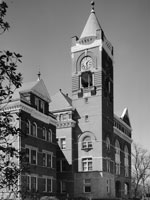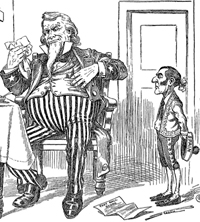Ben Tillman and Winthrop University

In what town did Benjamin Ryan Tillman found a normal school?
It depends on what you mean by "founded."
Benjamin Ryan Tillman was involved in the early development of both Clemson (now University) and Winthrop (now University). Clemson began as a military school, while Winthrop was for training teachers, which is to say that it was a "Normal school." In 1886, Winthrop was actually founded by educator David Bancroft Johnson in Columbia, SC with seed money from a Boston philanthropist. At that time it was known at Winthrop Training School for Women. Tillman, then the governor of South Carolina, made the school state-run in 1891 and it was renamed The South Carolina Industrial and Winthrop Normal College. In 1893, it was renamed again, and was known as Winthrop Normal and Industrial College.
The records say Tillman, who was then a U.S. Senator, was "instrumental" in having the school moved to Rock Hill in 1895, where it is today. Whether his role was so prominent that he could be said to have "re-founded" the school in Rock Hill is a matter on which historians have disagreed. The first building erected for the college in its new location was Tillman Hall, an ornate Romanesque-style building, constructed with convict labor from the state penitentiary. In 1920, the school became known as Winthrop College, the South Carolina College for Women. In 1974, the school became co-ed and changed its name again to Winthrop College. It was integrated in 1964 (arch-White Supremacist "Pitchfork Ben" Tillman would undoubtedly have been appalled). In 1992 the school became Winthrop University. It now has an enrollment of about 6,500 students in its liberal arts curriculum.
Benjamin Tillman served on Winthrop’s Board of Trustees from 1891 (he was its chairman at the time the school relocated to Rock Hill) until his death in 1918. He had sisters that either worked at or attended Winthrop. All three of his daughters attended the school.
Images:
Senator Tillman, his wife, and their daughter at the Democratic National Convention, 1912. Prints and Photographs Collection, Library of Congress.
Tillman Building, Winthrop College campus, Rock Hill, South Carolina, Historic American Buildings Survey, Library of Congress.
For many of the details of this answer, I am indebted to Gina White, the Director of Archives and Special Collections at the Dacus Library of Winthrop University.
Winthrop University's website.
Simkins, Francis Butler. Pitchford Ben Tillman, South Carolinian. Columbia, S.C.: University of South Carolina Press, 2002; orig. published 1944.
—— The Tillman Movement in South Carolina. Durham, N.C.: Duke University Press, 1926.
Snowden, Yates ed. History of South Carolina, volume 5 (Chicago: Lewis Publishing Company, 1920).
 Wearing breeches and a Union Jack waistcoat, John Bull once served as the symbol for the British everyman, but evolved into a symbol of the country as a whole. Both Britannia, the goddess-like female figure of England, and John Bull often appeared in political cartoons with Uncle Sam or Columbia—another name for Lady Liberty.
Wearing breeches and a Union Jack waistcoat, John Bull once served as the symbol for the British everyman, but evolved into a symbol of the country as a whole. Both Britannia, the goddess-like female figure of England, and John Bull often appeared in political cartoons with Uncle Sam or Columbia—another name for Lady Liberty.  In a spree of imperialism, the United States, represented by Uncle Sam, has "consumed" Hawaii (annexed to the U.S. on July, 1898), as well as Puerto Rico and the Philippines (though the Treaty of Paris and the acquisition of these as territories was still in debate in November 1898). Now, Uncle Sam turns to the figure of Spain—the cartoon's caption has him say, "Now, young man, I'll attend to your case." With the Spanish-American War over, the glutted U.S. prepares to attend to Spain itself, not just its colonies.
In a spree of imperialism, the United States, represented by Uncle Sam, has "consumed" Hawaii (annexed to the U.S. on July, 1898), as well as Puerto Rico and the Philippines (though the Treaty of Paris and the acquisition of these as territories was still in debate in November 1898). Now, Uncle Sam turns to the figure of Spain—the cartoon's caption has him say, "Now, young man, I'll attend to your case." With the Spanish-American War over, the glutted U.S. prepares to attend to Spain itself, not just its colonies. In the years leading up to the Spanish-American War and the U.S. metamorphosis into an imperialist world power, Uncle Sam was often drawn as a police officer. However, cartoonist Thomas Nast had already pictured Uncle Sam as a cop on the beat, policing U.S. political corruption, as early as 1888.
In the years leading up to the Spanish-American War and the U.S. metamorphosis into an imperialist world power, Uncle Sam was often drawn as a police officer. However, cartoonist Thomas Nast had already pictured Uncle Sam as a cop on the beat, policing U.S. political corruption, as early as 1888. For several decades, Uncle Sam was indistinguishable from an earlier character, Brother Jonathan, who also represented the U.S., superceding Yankee Doodle. By the middle of the 19th century, the same figure-by then clad in striped pants, short jacket, and top hat—was sometimes called Uncle Sam and sometimes Brother Jonathan. By about 1875, "Brother Jonathan" had mostly disappeared.
For several decades, Uncle Sam was indistinguishable from an earlier character, Brother Jonathan, who also represented the U.S., superceding Yankee Doodle. By the middle of the 19th century, the same figure-by then clad in striped pants, short jacket, and top hat—was sometimes called Uncle Sam and sometimes Brother Jonathan. By about 1875, "Brother Jonathan" had mostly disappeared. Often depicted in the French Revolution, Libertas wore a soft "liberty" or "Phrygian" cap. As Columbia, she could also wear feathers on her head, a reference to Native Americans, or a star or crown. The name "Columbia" fell out of popularity after World War I, and the character gained the names "Miss Liberty" or "Lady Liberty."
Often depicted in the French Revolution, Libertas wore a soft "liberty" or "Phrygian" cap. As Columbia, she could also wear feathers on her head, a reference to Native Americans, or a star or crown. The name "Columbia" fell out of popularity after World War I, and the character gained the names "Miss Liberty" or "Lady Liberty."
